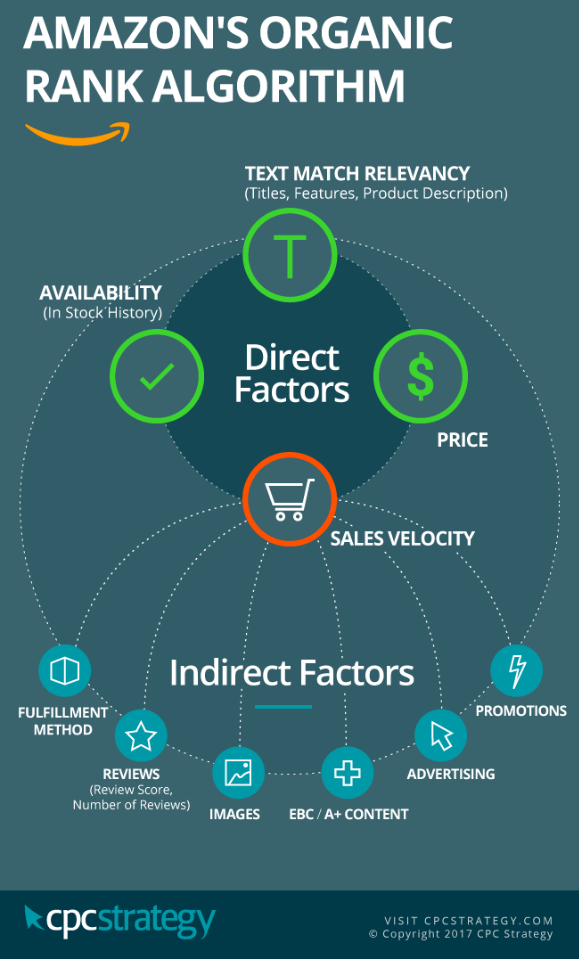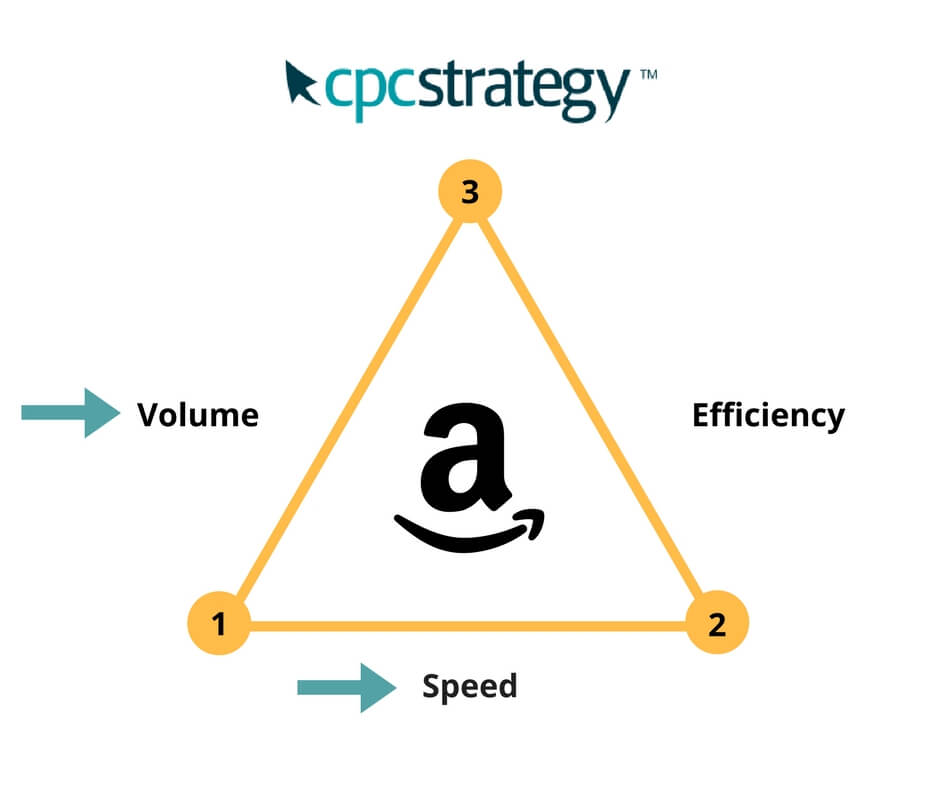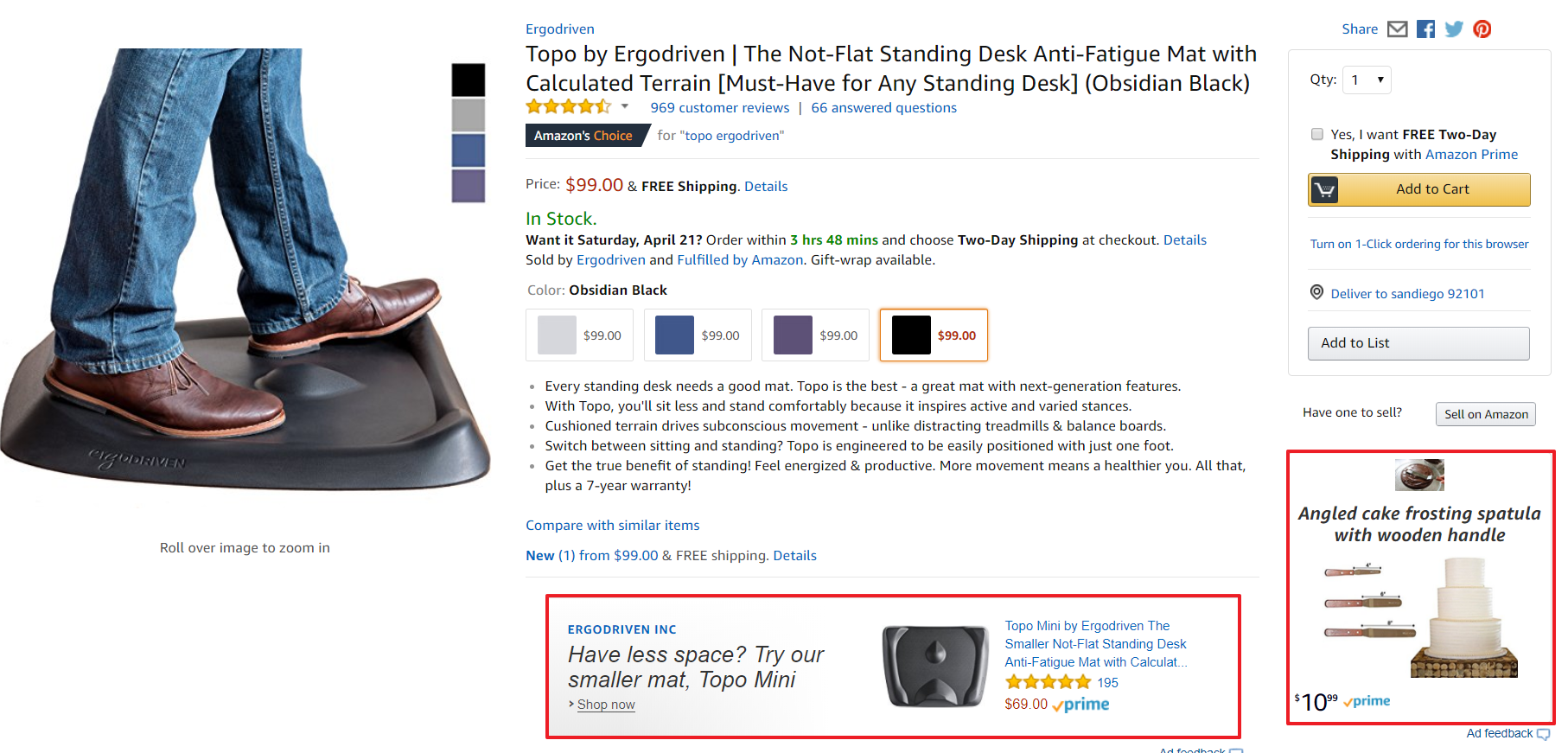You know what Amazon is. But did you know a 2018 study of 1,000 US shoppers found that 41% of of people start their product search on Amazon, and buy on Amazon.[*]

When we dug even deeper into Amazon shopper behavior, we found:[*]
-
70% of Amazon searchers never click past the first page of search results
-
35% of Amazon searchers click on the first product featured on a search page
-
The first three items displayed in search results account for 64% of clicks
You can either ignore the stats, or you can learn how to make Amazon work for you, to increase your sales and customer base.
In this article, I’ll teach you how to make Amazon your personal selling machine using Amazon Advertising. By the end, you will be ready to run your own Amazon pay-per-click (PPC) advertising campaign. Here is what we’re going to cover:
%(tableofcontents)
Why You Should Invest In Amazon PPC
Investing in advertising is not optional anymore on Amazon. New businesses are opening accounts on Amazon every day, flooding the market and increasing competition. Average cost-per-click (CPC) prices are rising in every category, even reaching the point of unprofitability in some cases, just to fend off competitors.
With all this competition some may ask if it is even worth investing in Amazon advertising. The answer is “absolutely yes.” With 49% of customers starting their product searches on Amazon, don't be passive — you can't afford not to pursue these shoppers.
So why do you need to pay for ads on Amazon?
Remember how 70% of searchers stay on the first page of search results, and the first three listings get the majority of their clicks? If you are not ranking at the top of searches organically — and even if you are — advertising is how you can get in front of those eyeballs.
Amazon’s algorithm has many ranking factors when deciding who ranks at the top for any given search, but sales velocity is the number one factor. Sales velocity is how many sales you are generating lately. It is not a specific metric Amazon gives you but more of a generalization of how many units you are selling per day.
Amazon is less concerned with cumulative sales and is more interested in the quantity you have sold recently. This is how new sellers can rise up on Amazon over veteran sellers by pushing more units per day than their competitors.
How do you generate sales velocity if nobody can find you? Advertising.
The infographic below is a visualization of what information Amazon provides regarding how their algorithm works. We have also confirmed these underlying factors through our own extensive testing.

Two primary factors drive organic sales rank: direct factors and indirect factors.
Direct factors are the most important.
If you do not have any stock when customers want to buy, no amount of advertising will help you because you cannot advertise sponsored products if you are not winning the buy box (i.e., the box on an Amazon product detail page where customers can begin the purchasing process by adding items to their shopping carts).
On Amazon, there can sometimes be multiple “offers” or people selling the same product. By default, Amazon chooses to show the product of the company they believe has the best offer based on price, reviews, fulfillment method, etc.
You can tell who is winning the buy box by seeing who it is “Sold by.”

If there were other sellers of this product, you would be able to view the various offers available.
Price is a core consideration for Amazon when determining which products will rank towards the top. If you drop your price your rank won’t immediately increase; however, if this price drop increases your conversions and sales velocity, you may see an improvement in ranking.
Text Match Relevancy examines if the product is relevant to the customer’s search. Ergodriven’s ads and sponsored product listings are not going to show for the search “dog treats” even if they have a $20 bid, because Amazon knows their products are not relevant to that search.
Advertising your products is one of many factors that can influence and drive sales velocity among promotions, content, reviews, etc. I’m going to show you how to do it now, for your own ecommerce business.
How To Determine Your Amazon PPC Goals
First, let’s take a look at the types of ads you can run and the strategies for using each.
There are a few different types of Ads. If this is too basic for you, skip to the Goals section.
Sponsored Product Ads
Sponsored product ads look like regular organic listings, but have a sponsored badge (see screenshot below). They also appear in carousels and Amazon will likely add additional placements for them over time.

Sponsored product ads consist of auto and manual campaigns.
Auto campaigns are based on the content on your product page. Amazon’s algorithm determines if your ad is relevant for a given search based on the search query and your product page text match relevancy.
Manual campaigns are based on keywords you bid on with varying match types (broad, phrase, or exact match).
Use auto campaigns to gather search term data which you can apply to your manual campaigns.
Here is a search term report with some examples of keywords we have converted on at a good advertising cost of sale (ACOS) and would want to add to our manual campaigns.

Here some keywords which are not relevant and luckily we spent very little money on these:

If you convert on a search term in your auto campaign, add it to your manual campaign and set a specific bid for that keyword. This is a strategy called keyword harvesting.
Headline Search Ads
Above the sponsored product listings you will see Headline Search Ads. This is premium real estate as it is the first thing a customer will see after they search. You also get to feature multiple products, write unique ad copy, and can link to a separate landing page not on Amazon with additional products, or even an Amazon Store. (Example Amazon Store)

All of these additional features typically come at higher CPCs, but can also drive a significant amount of sales volume for your business.
Product Display Ads
Product display ads (PDAs) have a few different placements as shown below. PDAs can be used to target competitors product pages or defend your own pages.

Setting Goals
What are you looking to accomplish with your ads? Grow sales volume quickly? Acquire customers more cost efficiently? All the above right?
As nice as that would be, it is better to focus on two of the three sides of what is referred to as the Amazon Advertising Triangle at a time.

Scenario 1: Push sales volume quickly
If you want to push volume quickly, you are going to sacrifice efficiency. If you increase all your bids by 150%, you don’t know if you will receive an equal return in sales due to the law of diminishing returns which will drive up your ACOS.
Scenario 2: Improve efficiency quickly
When I refer to improving “efficiency,” I mean lowering the cost of your advertising. For example, if you generate $100 in sales with $10 instead of $20 you would be improving your efficiency because your ACOS is now 10% instead of 20%.
ACOS = (Spend/Sales) x 100
The less you have to spend on your advertising the better as it will leave you with more margin. Thus, “more efficient.”
Focusing solely on this strategy will reduce your sales volume because even keywords which are not performing efficiently are still generating sales for you. The only time when you won’t affect sales would be on keywords which you were spending money and not receiving any sales. These are quick wins and a great way to quickly improve efficiency without sacrificing volume.
Scenario 3: Increase volume and efficiency
To increase volume and efficiency, you need time. This is the long-term strategy you want to shoot for and is what your focus should be once you are up and running.
You need time to tweak and identify the keywords to bid on and how much to pay for them to ensure you are profitable on them. Even when you find the right bids for your keywords, they are a moving target as the competitive landscape is always changing and requires updating bids to stay ahead of the competition, seasonality, etc.
Understanding the push and pull system of these three main goals will be important in developing your businesses Amazon PPC strategy.
Best Practice For Structuring Your Amazon PPC Campaign
Amazon PPC ad campaigns are broken out like this:
Campaign
-
Ad Group 1
-
Keyword
-
Keyword
-
-
Ad Group 2
-
Keyword
-
Keyword
-
You can have multiple products in an ad group, and those products will show up for the keywords in that specific ad group.
When it comes to structuring your campaigns, the more granular, the better. For most businesses, I recommend having a separate ad group for every Product/SKU. If your catalog is small enough, say under 50 products (including variations) you can create a separate campaign for every product and still be able to manage everything.
When I refer to “products” in this case, I am referring to essentially product variations. If it is a totally separate product, it should have its own campaign.
For example, a specific baseball bat which comes in three sizes: 32, 34, or 36. A separate baseball bat which serves a different purpose should have its own campaign.
If you are trying to decide whether to combine multiple products into a single ad group or separate them, I would ask yourself the following questions:
-
Will the products require unique keywords?
-
Do I want the ability to control how aggressive I push one product over the other?
Sometimes if your products are similar enough, you do not need to have a separate ad group for them. However, if a unique set of keywords will be important, you will want to separate them.
For example, if you are selling baseball bats which come in different weights and sizes where a customer would be searching for a specific size, you would likely want to separate different bat lengths in their own ad group so you can have keywords like:
– Men’s baseball bat 34”
– Men’s baseball bat 32”
Having separate ad groups for each product also allows you to allocate specific bids to each product if you want to push one more than the other. If they are in the same ad group, they will use the same bid allocated to that ad group.
This can be beneficial when your products come in different colors, sizes, etc., and people are using those modifiers in their search. For example, for the search “men’s large black crew neck t shirt” you don’t want your “men’s medium red crew neck t shirt” showing up for this search and wasting your ad spend.
More advanced strategies involve breaking your campaigns out into Branded, Non-Branded, and Competitor terms where each campaign has keywords specific to their goal. Breaking campaigns out like this also allows you to track the performance of branded vs. non-branded keywords as performance typically varies drastically between the two categories.
Two Amazon PPC Strategies That Work
Amazon PPC Strategy #1: Optimizing Your Bids
Optimizing your bids is a never-ending game when you are competing on Amazon. Bids need to be continuously adjusted to stay ahead of the competition, grow your sales, and maintain efficiency.
Your bid optimizations will be guided by your goals, which we discussed earlier. You will also want to keep your ACOS goal in mind when determining whether to increase, decrease, or leave a bid.
Example Scenario 1
Goal: Grow sales volume and improve efficiency
ACOS Target: 10%
You are looking at a keyword with the following metrics over the past 14 days:
-
Keyword: Standing desk mat
-
Bid: $1.50
-
Average CPC: $1.15
-
ACOS: 15%
This keyword has been driving a good amount of sales over the past two weeks. However, the AOCS is currently 5% above your target. I would do one of two things in this situation.
-
We are currently paying above the average CPC which means we are likely winning an ad spot a good amount of the time. We could try lowering our bid to $1.10 where we will not win as often, but our average CPC should come down which will result in a lower ACOS granted we do not lose more in ad revenue than we saved in spend.
-
Leave the bid as is. If a core keyword is a bit above your goal, you may be OK being less profitable as you are still generating sales for a core keyword which can improve your organic rank.
Example Scenario 2
Goal: Grow sales volume and improve efficiency
ACOS Target: 10%
You are looking at a keyword with the following metrics over the past 14 days:
-
Keyword: Desk accessories
-
Bid: $1.50
-
Average CPC: $1.15
-
ACOS: 35%
This keyword is clearly operating above our ACOS target. It is also not a hyper-relevant keyword so it is not one I would be willing to be so far over our ACOS target, so I would reduce the bid to below the current average CPC.
For a 10% ACOS target like the examples above (where you don’t want to spend more than 10% of your sale price to generate a sale) use my bid optimization guide below to adjust your bid based on the ACOS percentage of your keywords.
Amazon PPC Bid Optimization Guide
Amazon PPC Strategy #2: Keyword Harvesting
Keyword harvesting is an essential part of any Amazon advertising strategy and is essentially buying data to do market research. It is the process of gathering search terms which customers are using to find your products via your auto campaigns. This is why it is essential to have strong, descriptive written content on your product detail pages. This is how Amazon’s algorithm better understands your products and determines whether your ad will be relevant for a given search.
How does this differ from using third-party research tools? Gathering search term data from your auto campaigns is the best data you can collect because it will pull searches from actual paying customers and shows you how much money it took to convert them. Third-party research tools only give you estimates of what people are searching.
Using third-party tools are still beneficial though and can help get you jump-started. I have tested many, but the best one I’ve seen is Viral Launch.[*]
How To Keyword Harvest
-
Download the search term report in your Seller Central Account. The search term report contains the search terms your auto campaigns picked up. Essentially, if someone searched something and clicked your ad, the search term report will collect that data.
-
Go to Reports > Advertising Reports > Search Term Report > Download Report

I generally look at data from the previous 30 days or however long it has been since your previous harvest.
I would suggest doing this every 3-6 weeks.
Not all search terms you convert on are created equal. If your goal is a 20% ACOS, I would suggest taking keywords you have converted at a 30% ACOS or lower. I typically go above goal as auto campaigns do not perform as well, so I wouldn’t want to not add a keyword just because it is a bit above goal. If you are less budget conscious, I would go even higher.
Now that you have your list of keywords you want to add back to your manual campaign, there a few more steps.
To maximize exposure, use all three match types (Broad, Phrase, and Exact).
-
Broad match does not need to contain the exact keyword; it only needs to be relevant and thus will have the most exposure.
-
Phrase match must contain the keyword in some portion of the search.
-
Exact match will only show for the exact keyword.
Use bids based on your average CPC which you found in your keyword harvest.
Set your bid 15% above your average CPC for broad match, 15% above that for phrase, and 20% above phrase for your exact match.
Now add those keywords to your manual campaigns.
How Ergodriven Used Amazon To Increase Sales By 57% In 5 Months
I used the strategies outlined above to grow Ergodriven’s Amazon ad revenue and improve efficiency in their account.
They were heavily targeted by direct competitors who were advertising on their product pages and stealing away sales. To combat this, I created defensive product display ads with aggressive bids to fend them off.

Amazon has since added an additional ad placement on product detail pages, so it is now quite difficult to win both spots on your own product, even with very aggressive bids. You can see we have one and an unrelated competitor has the other. You have no control over which one you will show up in.
We also identified competing and related products to target with product display ads using an offensive strategy and compelling ad copy.

Coming up with ad copy for ads in Amazon is difficult as the character limits are very limited (50 characters for PDAs) and there are restrictions on what type of claims you can make. For example, “The best standing desk mat!!” would not be approved because you have nothing to back up the claim of it being “the best.”
3 Key Takeaways To Grow Your Business With Amazon PPC
-
Define your goals and calculate your ACOS target. If you don’t know what your ACOS target is, you won’t have a baseline of what to base your bid optimizations off of. You will be flying blind if you don’t know what your goals are
-
Advertise to your strengths. Some products just may not work out. Don’t waste spending your money driving traffic to products which are consistently not converting. Spend those dollars driving traffic to your top products for maximum profitability
-
Don’t get too caught in the weeds. Optimizing bids is important, but obsessing over small tweaks every day will take up too much time and not be beneficial. Just because you over-spent for one day doesn’t mean you need to pause the keyword. Look at trends over longer time periods and don’t overreact to short-term trends. Amazon is an ever-changing, complex marketplace and your bids are only one small aspect of a much larger system at work.










Add A Comment
VIEW THE COMMENTS